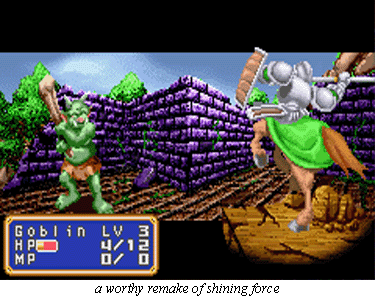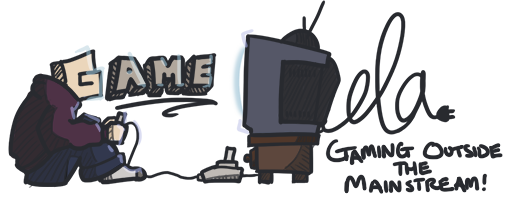Guest review by: Peter Butter
Shining Force – Resurrection of the Dark Dragon, a remake of the 1993 Sega Genesis title Shining Force, is a tactical RPG in which you lead a group of adventurers against the armies of an evil neighboring country. But this is far more than just a port with updated graphics; Shining Force has been redone from scratch, and a fine balance has been struck between preserving the classic game and updating it to stand up to the many other tactical RPGs on the GBA. As such, the end product is likely to please both fans of the original and newcomers to the Shining series.

The story of Shining Force centers around the young swordsman Max, who is thrust into the middle of a conflict over an ancient evil sealed away long ago. Max, as the newly updated story of RotDD tells us, was washed ashore a year ago in the country of Guardiana, and has no memories of his past. This convenient bit of RPG cliché obviously results in shocking revelations about his past later on. Nothing too original, but a lot better than having no back story to speak of at all. Over the course of a journey to the heart of the enemy country, Max and his force of up to around thirty other characters fight the armies of Runefaust, with a maximum of 12 characters to be fielded in each battle. Opposing them are a host of different monsters, from the wimpiest goblins to the biggest wyverns and minotaurs, and with only a little palette swapping going on. The focus is definitely on these battles. In between, there’ll be some short town scenes and minimal exploring, but basically it’s just outfitting your characters for the next battle. Unlike the original, however, there is a lot of dialogue and story during these intermissions. This is a significant improvement which lends the game a lot of atmosphere, and yet feels natural and in keeping with the Shining series as a whole. Scenes which raised more questions than answers 11 years ago are now fleshed out with more detailed explanations; no more wondering why the villains frequently skip a chance to cut Max down where he stands. Also, the silent protagonist Max has now become talkative, and the characters who can be recruited into your force now have back stories which they may reveal to you over time, but only if you use them in battle a lot. The wacky humour of the original game hasn’t been forgotten either, and much of the dialogue is aimed at providing a little comic relief to alternate with the action. You know you’ve got a game that doesn’t take itself too seriously when an evil wizard snarls at his followers: “Ssh! Don’t interrupt me while I’m cackling gleefully!”
As you work your way through the battles and the eight chapters of the game, visiting many different locations including a school of mages (including hilariously inept ones), a tropical mermaid’s island, and a deserted city that once belonged to the Dragon Gods, more is revealed about the enemy’s intentions. What started as a mere skirmish at an ancient gate becomes a race against time to keep the evil Dark Dragon from being resurrected, something with which Max is more personally involved than he could have imagined. The story brings nothing wildly original to the RPG scene and is nowhere near as complicated and political as is typically seen in tactical RPGs. Whether that’s a good thing or not, I’ll leave up to you; I much prefer being able to play without having to take notes, but if it’s the twisting story that you enjoy the most about this style of game, Shining Force is probably going to disappoint a bit. It’s all about combat here.

In a typical battle, Max, who is the only mandatory character, and up to 11 allies chosen from your recruitees sweep across the battlefield, through various kinds of terrain. Sometimes you’ll be fighting indoors or in open plains, where everybody moves quickly. Other times you might find yourself in the mountains where your usually lightning fast knights slow down to a crawl, or in the desert where nobody seems to be in a hurry. And everywhere, hordes of enemies are waiting for you to seek them out and destroy them. Usually they are content to wait for you to come close, although they’re not as passive anymore as they tended to be in the original. Every time two characters attack each other, a close-up animation is seen in which the attacker lashes out at his target, after which a second strike and/or a counterattack may follow. These animations add a lot of personality to allies and enemies alike, and many look pretty good up close. Knights drive their lances straight into the enemy, warriors swing axes that are almost as big as they are, and the werewolf hurls himself into the enemy with a deadly spinning attack. Some of the animations literally have you wincing as you see the hit connect.
Characters gain experience from every attack and (especially) every kill they score, and will level up quicker if you use them more. If a character does fall behind from neglect, training them back up can be tricky, but fortunately you have so many to choose from that you can usually just ditch them for a newly recruited character if this happens. The original Shining Force had an impressive 30 characters, including Max, and the remake adds three new ones which join about halfway through the game. Furthermore, each comes with interesting new abilities. A particularly noteworthy newcomer is Mawlock, the Card Master, who can use cards that you collect throughout the game to provide special boosts to certain characters or imitate them. If used well, he can upset the balance of the game quite a bit, but he’s fun to play around with and can always be left off the battlefield if you feel he ruins your game.
Compared to some of the other tactical RPGs on the GBA, Shining Force has rather simple battle mechanics, but it executes them with style. The large selection of characters means you can build your force in many different ways, perhaps focusing on a large group of knights one game, going with lots of mages the next, or taking good advantage of flying characters who do not benefit from the cover of heavy terrain, but always move fast and can launch some very impressive flanking attacks in the right battles. A few characters start out weak but become regular powerhouses if trained up a lot, and doing so can be incredibly satisfying. Getting to know each character’s peculiarities in battle already warrants several playthroughs, and with back stories to discover and character cards to collect, the incentive to play again is significantly raised from the original game. Further replay value has been added by allowing any player who finishes the quest to start one that is just a little harder; all enemies get some boosts to their statistics, making the battles that much harder. Finish it again, and the monsters will get boosted some more. There is no limit to this, and thus you can replay the game as often as you like and get harder and harder battles until you meet your match. Granted, it’s a bit of an easy way to introduce extra challenge and to try to squeeze more replay out of a game, but it’s better than nothing, and most RPGs do not make any attempts in this regard. No dedicated Shining Force player can complain his game is too easy this time around; likely he’ll be playing it through six or seven times and get to the point where every battle is damn hard.

Speaking of difficulty, some significant rebalancing has taken place since the original. I’ve already mentioned that monsters aren’t as passive as they used to be, which makes some battles a lot harder. Where monsters used to stand still and get clobbered from a distance, here they’ll swarm your characters as they approach, guard choke points, and actively try to stop you from getting too many characters in. A fine example comes halfway chapter four, where what used to be one of the most hilariously easy battles in the game is now a desperate fight for control as enemies block the top of ladders and force you to face them in single file, almost inevitably losing a few characters. Other battles in the original were surprisingly hard, with monsters that did far more damage than you’d expect at that stage of the game; and sure, enough, these monsters have been toned down, resulting in a much more stable challenge throughout. The restless rising and falling of challenge that so many players noticed in the original Shining Force has been well smoothed out, and although as a whole the first playthrough has become a little easier, that’s where the aforementioned replay modes come in. Furthermore, the developers haven’t neglected the specific needs of a handheld game, and made sure you can save your game anywhere, in the middle of a battle if needs be.
Graphically, the game has obviously been redone, as well. Mostly for the good, taking full advantage of lush colours (here’s one game that won’t be too dark to play without a field light!) and crisp animation, which goes through far more frames than the original. Only a few complaints in this area: character portraits have been redone, but not always for the better, and the characters in battle are now significantly taller and obscure the square just behind them, which makes it harder to see exactly where a character can move. Often, you miss the spaces just behind other characters. This is mostly something to get used to, though. Other areas of RotDD remain largely unchanged from the original. The classic soundtrack remains, which in my opinion is a case of ‘if it ain’t broke, don’t fix it’, as it was great music to begin with. Most of the tunes sound fitting to the business at hand, with merry carefree town themes, upbeat tunes for battles, and the more ominous music reserved for fighting the big name enemies. Apart from a little too much repetition, the soundtrack is solid and can still stand up to GBA games that came decade later. Sound effects, as before, are crisp and effective, if not superb. The sound of swords striking armor in battle is surprisingly realistic and a notch above everything else.

All in all, Resurrection of the Dark Dragon is a worthy remake of Shining Force, preserving the original game as much as possible but also tackling most of its flaws. It’s a perfect way to revisit an old game, and a worthy addition to any RPG collection. Shining Force may not be as complicated or deep as some of the more recent games, but it clearly shows that pure quality isn’t negated by a mere decade, and that this series still shines (pun fully intended) to this day.
